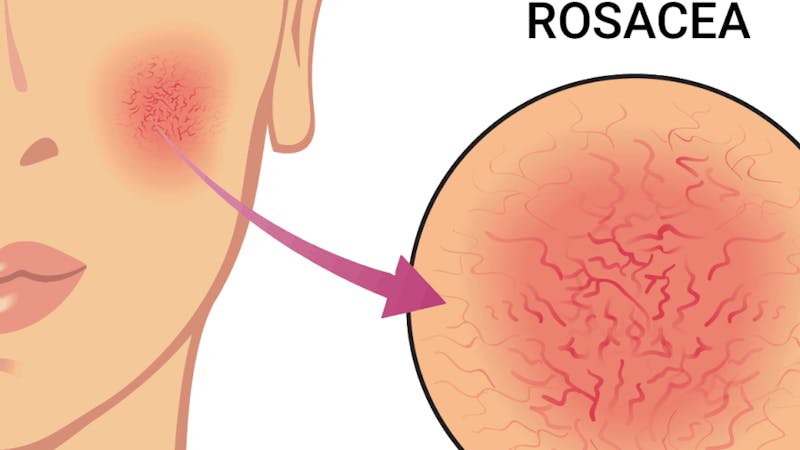
Managing Rosacea
March has been known as a tough month for patients with certain skin conditions so let’s talk about one of the common ones -Rosacea. Rosacea affects at least 14 million people in the U.S. and can be a frustrating and painful condition to deal with. However, you can manage it effectively by some tweaks in behaviors, lifestyle, and skincare routine.
Are you ready for clear, calm skin? Keep reading!
What is Rosacea?
Rosacea (roe-ZAY-she-uh) is a common inflammatory skin condition that causes redness and visible blood vessels in your face. It may also produce small, red, pus-filled bumps. These signs and symptoms may flare up for weeks to months and then go away for a while. Rosacea can be mistaken for acne, other skin problems or natural ruddiness. There’s no cure for rosacea, but treatment can control and reduce the signs and symptoms.
These are the most common signs and symptoms:
1. Facial redness. Rosacea usually causes a persistent redness in the central part of your face. Small blood vessels on your nose and cheeks often swell and become visible.
2. Swollen, red bumps. Many people with rosacea also develop pimples on their face that resemble acne. These bumps contain pus. Your skin may feel hot and tender.
3. Eye Problems. Many people with rosacea also experience dry, irritated, swollen eyes and red, swollen eyelids. This is known as ocular rosacea. In some people, the eye symptoms precede the skin symptoms.
4. Enlarged nose. Over time, rosacea can thicken the skin on the nose, causing the nose to appear bulbous (rhinophyma). This occurs more often in men than women.
Though it’s rare, Rosacea can sometimes cause the skin to become bumpy and thicken (especially on the nose).
Who Gets Rosacea?
Rosacea can affect anyone but is most found in people with fair skin. This doesn’t mean other skin tones can’t experience rosacea, though. It’s a lot more likely to be misdiagnosed or missed entirely in patients of color because they don’t always present with classic redness. Other signs and symptoms to look for include warm-feeling skin; dry, swollen skin; a dusky brown discoloration; acne-like breakouts that come and go and don’t clear with treatment.
You’re also more likely to develop rosacea if someone in your family has had it or if you’ve experienced lots of acne at some point. It’s not uncommon for rosacea to develop after the age of 30.
Know your Triggers!
• Sun Exposure
• Emotional Stress
• Hot Weather (hot baths, showers, saunas, or hot tubs, etc.)
• Wind
• Exercise
• Spicy Food
• Alcohol Consumption
• Certain Skincare ingredients or medications
This list is by no means extensive, and it’s important to note that not all rosacea patients will have the same triggers. For example, one rosacea patient might react negatively to a skincare ingredient that another rosacea patient can use without issue. Because it’s so individual, you really must be your own skin detective.
Suggested products and procedures
Our patients suffering with this condition have seen much improvement when using these ZO Skin Health products: Exfoliating Cleanser, Oil Control Pads, Dual Action Scrub, Daily Power Defense, Wrinkle and Texture, Growth Factor Serum, Complexion Renewal Mask (sulfur), Instant Pore Refiner, Enzyme Peel, Complexion Clarifying Serum, SPF Primer, or Broad-Spectrum Sunscreen.
We have also seen results with Stimulator Peels, HydaFacial Deluxe with Blue Light Therapy, Rozatrol Booster, Microneedling with PRP, BBL or Moxi Laser.
Tips for Managing Rosacea
The true root cause of rosacea is still unknown, and it’s likely more than just a single factor. Like acne, rosacea is a systemic, inflammatory disease for which there is no known cure. The key is managing it successfully to be able to minimize flare-ups as much as possible. By working with a professional, identifying your triggers, and building the right skincare routine (see below), you can get your skin to a much better place.
Building a routine
1. Cleanse gently, every day. This means both morning and evening! Cleansing can help remove dead skin-cell buildup from the skin (removing buildup can help keep flare-ups under control).
2. NEVER skip sun protection. Sun exposure is one of the top triggers for rosacea. Use a broad-spectrum sunscreen every day in addition to wearing sun-protective clothing and avoiding direct sun exposure during peak daylight hours.
3. Exfoliate (carefully). Removing dead cell buildup from the skin can help keep your moisture barrier balanced, which in turn can help mitigate rosacea flare-ups. Exfoliating is a great way to do this, but those with rosacea should proceed with caution. You may not be able to exfoliate as frequently as other people.
4. Hydrate. It may seem obvious, but the importance of keeping rosacea-prone skin well-hydrated really can’t be overstated. As is the case with pretty much any skin condition, maintaining a healthy moisture barrier is key.
Keeping rosacea under control can feel like an uphill battle, but many patients have significantly improved their skin by diligently following these tips! Hard work pays off, and clearer, calmer skin is possible.
If you are struggling with this condition, give us a call or text us at 804.378.7443 to schedule a consultation with our Master Aesthetician, Franki. She would love to help you on this journey!



